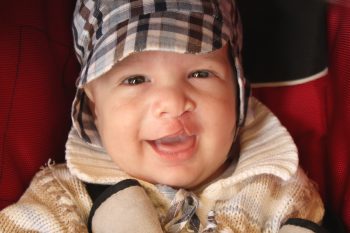
A study conducted by an international research team, which included investigators from Seattle Children’s Research Institute, implicates variants in four genes as a primary cause of non-syndromic cleft lip and palate in humans. The genes, associated for the first time with cleft lip and palate, encode proteins that work together in a network, providing important insight into the biological basis of one of the most common physical malformations.
Representing about 70% of cleft lip and palate cases worldwide, non-syndromic cleft lip and palate typically occurs in isolation without other physical abnormalities. This craniofacial malformation has long been considered to be caused by a combination of many common genetic variants and environmental factors, each contributing a small amount to the risk of a child being born with a cleft.
Published in the American Journal of Human Genetics, the study provides the first evidence that a significant number of non-syndromic clefts have a single gene basis and not a complex basis as previously thought.
Study of extended families gives definitive genetic clues
The collaboration between Seattle Children’s, the University of Washington School of Medicine, Neuroscience Research Australia (NeuRA), Radboud University Nijmegen, and the University of Iowa used next generation sequencing to study 72 large families in which multiple individuals were affected with non-syndromic cleft lip and palate.
Dr. Timothy Cox, a member of the research institute’s Center for Developmental Biology and Regenerative Medicine and Seattle Children’s Craniofacial Center co-led the study with Dr. Tony Roscioli, an associate professor from NeuRA, the Sydney Children’s Hospital at Randwick and UNSW Sydney. Together, they devised a different approach to study the genetic basis of non-syndromic cleft lip and palate.
“Prior studies have focused on using large numbers of affected individuals without an obvious family history, searching for common genetic variants that are associated with an increased risk of a child being born with a cleft,” Cox said. “Our new findings indicate that non-syndromic cleft lip and palate occurring in families is more likely to be caused by a rare variant that we can pinpoint using available new sequencing technologies.”
Key cleft lip and palate pathway emerges
Whole exome sequencing results showed that genetic variants in the four newly implicated genes in addition to another gene previously associated with non-syndromic cleft lip and palate accounted for 15% of the families who took part in the study and in nearly 3% of a second, larger group of smaller families and isolated cases used to validate the findings.
The five functionally-linked genes play an important role in the regulation of a pathway known as the epithelial cadherin-catenin complex. Since this complex connects to other genes previously associated with non-syndromic and syndromic cleft lip and palate, the findings could lead to new diagnostic tests and treatments for cleft lip and palate.
“The genetic pathway that emerged from this data is arguably one of the most significant advances in cleft lip and palate genetics in the last 15 years,” said Cox, who is also a professor of pediatrics in the UW School of Medicine. “The pathway provides a target for future studies that explore ways to impact or modify the pathway to prevent cleft lip and palate.”
Future research
Cleft lip and cleft palates are repaired with corrective surgery. Future research will further investigate the biology and link the findings to future potential therapies. These discoveries will allow geneticists to provide more accurate information to families.
“Importantly, we also showed that some affected individuals in this study had a gene variant which was inherited from neither parent – that is, it likely arose spontaneously in the affected individual during early development – and therefore the parents were able to be reassured of a very low chance of having another affected child,” Roscioli said.
Cox’s lab at Seattle Children’s is also studying how maternal nutritional factors interact with genes to control the formation of the unborn child’s face and how these factors impact a child’s risk of being born with cleft lip and palate. He hopes his research will lead to innovative approaches to reduce the severity or incidence of cleft lip and palate in newborns that carry a genetic predisposition to the birth defect.
“While not everyone who inherits one of these genetic variants will develop a cleft lip and palate, it substantially increases their risk of being affected,” Cox said. “Through our continued research, I believe that one day it will be possible to predict an individual’s risk of developing a cleft and hopefully provide simple dietary modifications to prevent or reduce the severity of the disorder.”
This study was supported by grants from the Australian Health & Medical Research Council, the Laurel Endowment for Pediatric Craniofacial Research, the March of Dimes and the National Institutes of Health.

